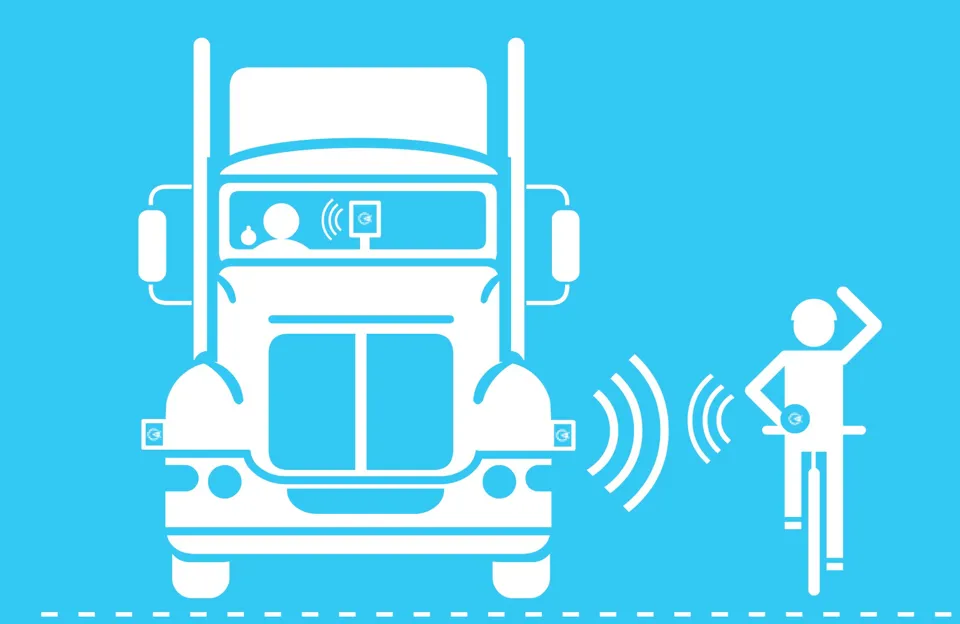A new cycle safety initiative is set to roll out nationally, after trials with a number of fleets in York.
The City of York Council has fitted the cyclist detection product from Cycle Alert to six trucks, while local bus companies First Group and Transdev and private-sector company Nestlé have also invested in the system.
Cycle Alert is a device placed on a cyclist’s helmet or bike which sends signals to a sensor on the exterior of a vehicle. This signal is passed to a device in the cab which alerts the driver to the presence of the cyclist in their blindspot within 2.5 metres. An LED display shows the driver the position of the cyclist.
The wireless kit costs £400 per vehicle and is expected to have an operational life of 10 years, while cyclists can collect an electronic tag for free from participating cycle shops.
So far, 3,000 cyclists have fitted the device in York (10,000 across the UK), while around 40 buses and a similar number of trucks have sensors. Cycle Alert is also in talks with other companies in Yorkshire and elsewhere, including one which could result in an order for 1,600 vehicles.
The trial was launched after the council approached Cycle Alert. “York City has a cycling pedigree,” said Cycle Alert managing director Peter Le Masurier. “It is also a university town, and is very keen to safeguard its students.
“The trial has been very successful. Obviously, there have been no cyclists knocked down, but our aim has always been to open the door to education.”
To support this aim, Cycle Alert has brought together cyclists and drivers at a ‘switching places’ event in York.
“Nestlé brought a KitKat branded artic and invited cyclists to sit in the cab, to see things from an HGV driver’s perspective,” said Le Masurier, who is himself a keen cyclist. “They could also view a map of an HGV, showing their blind spots.”
Meanwhile, bus drivers have taken part in safety training by cycling around York City, to enable them to see things from a cyclist’s point of view.
“We got a lot of comments like ‘that truck got very close’ and ‘I’ve not been on a bike for years’,” Le Masurier said.
In terms of the product, Le Masurier claimed feedback has been good. “Of the operators that have been trialing it, around 90% of them said they’d recommend it and, so far, we’ve not had anyone send it back after the trial.”
However, not everyone is convinced. Concerns have been raised about the software from cyclists groups who fear that drivers may become reliant on a system which leaves untagged cyclists unprotected. They also question whether the kit is failsafe.
Nevertheless, Cycle Alert is now expanding nationally. New customers include Veolia (fleet size: 9,100) and Croydon Council, which operates 190 vehicles, while Merton Council and Sutton Council in London are carrying out trials. Devices have been fitted to everything from flat beds and tippers to tow trucks.
The system requires widespread take-up by cyclists and fleets alike to be viable. In London, Le Masurier has been talking to Transport for London (TfL) about fitting Cycle Alert to the ‘Boris Bikes’.
TfL commissioned the Transport Research Laboratory to carry out two sets of trials, although the results have not been released, due to issues with the methodology. Cycle Alert is hopeful that a third trial will be undertaken, possible via the Department for Transport, who would lay down proper parameters.
TfL already promotes cyclist software after developing a programme with ProNav for its sat-nav system. It provides van and truck drivers with an audible and visual alert as they approach a junction (or section of road) that has been identified as a location with high volumes of cyclists.
Meanwhile, Sentinel Systems has developed Bike Hotspot, which comprises four safety aids: front corner system, side scan system, a side camera and an external sounder. Sensors are linked to an internal audio warning to alert the driver when there is a potential hazard, while an external alert warns the cyclist that the vehicle is turning left.
Lord Atlee, speaking in the House of Lords recently, raised the prospect of “tag-and-beacon” cycle alerts becoming more widely adopted with the backing of Government.
“I have proposed a system whereby one or more infrared transmitters are fitted to the relevant truck. The cycle has a transducer mounted on it which retransmits the signal back to the truck,” he said.
- Find out how we got on behind the wheel of a Volvo truck on London’s busy roads – click here.

















Login to comment
Comments
No comments have been made yet.